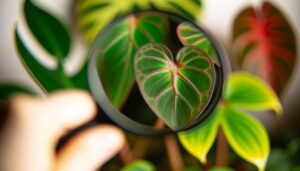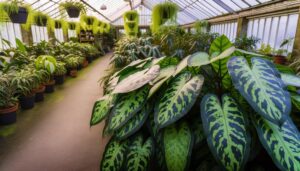What Is a Black Cherry Pink Princess Philodendron?
The Black Cherry Pink Princess Philodendron is a unique cultivar originating from controlled hybridization efforts. Characterized by its distinctive variegation, the foliage showcases vibrant pink, deep burgundy, and green hues due to a genetic mutation affecting chlorophyll production.
Glossy, heart-shaped leaves and aerial root nodes enhance its visual appeal. Optimum growth conditions include well-draining soil, consistent indirect light, and balanced moisture levels.
Propagation is achieved through stem cuttings, and maintenance involves a blend of peat, perlite, and orchid bark for proper drainage. By adopting these best practices and addressing common issues such as leaf yellowing or root rot, enthusiasts can ensure strong growth and vivid coloration.
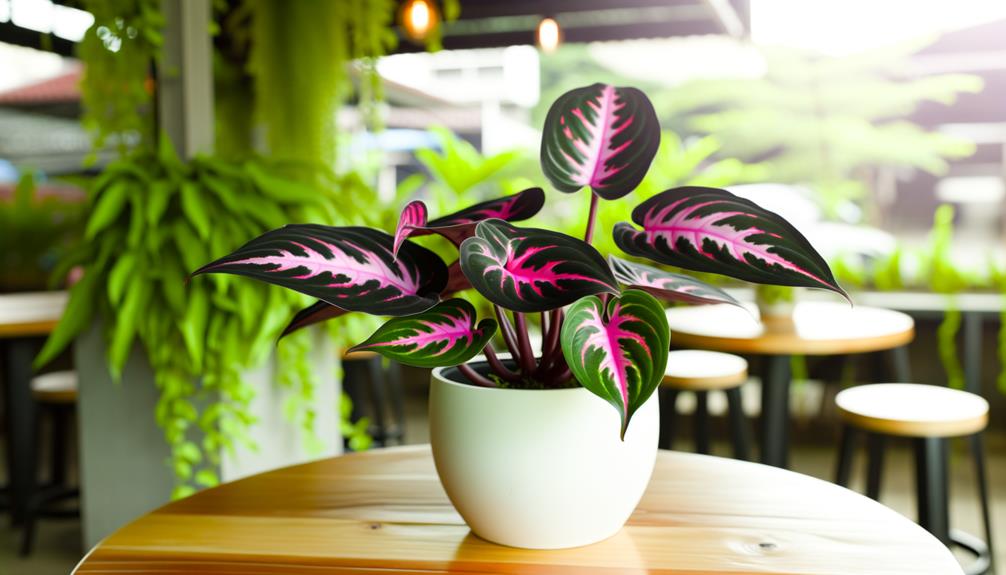
Key Takeaways
- The Black Cherry Pink Princess Philodendron is a hybrid cultivar known for its vibrant pink, deep burgundy, and green variegated foliage.
- It features glossy, heart-shaped leaves with unique variegation patterns caused by a genetic mutation.
- Ideal growing conditions include well-draining soil, indirect sunlight, and balanced moisture levels.
- Propagation is achieved through stem cuttings with at least one node and proper humidity.
- Common care issues include leaf yellowing, root rot, and pest infestations, which can be managed with appropriate soil, light, and pest control measures.
Origins and History

The Black Cherry Pink Princess Philodendron, a mesmerizing cultivar known for its striking variegation, traces its origins to the hybridization efforts of botanists seeking to enhance the aesthetic appeal of the Philodendron genus.
This cultivar emerged from controlled crossbreeding experiments designed to amplify the naturally occurring variegation patterns found in Philodendrons. The process involved selecting specimens with desirable genetic traits, ensuring the propagation of vibrant pink, deep burgundy, and green foliage.
Over time, these efforts culminated in the creation of the Black Cherry Pink Princess, a plant that exemplifies the beauty and diversity achievable through meticulous cultivation.
To maintain its vibrant appearance, ideal growing conditions include well-draining soil, indirect sunlight, and regular watering, ensuring the plant's health and longevity.
Unique Characteristics
Renowned for its distinctive variegation, the Black Cherry Pink Princess Philodendron boasts a unique combination of vibrant pink, deep burgundy, and lush green foliage that sets it apart from other cultivars. The variegation results from a genetic mutation causing chlorophyll deficiency in certain leaf areas, producing strikingly pigmented sections.
Each leaf exhibits a unique pattern, with some displaying mainly pink or burgundy hues, while others showcase a balanced mix. The plant's elongated, heart-shaped leaves are typically glossy, enhancing their visual appeal. Nodes on the stem often develop aerial roots, assisting in nutrient absorption and stability.
Best variegation is achieved through consistent, indirect light exposure, which encourages the vivid coloration without causing leaf burn or excessive chlorosis.
Care Requirements
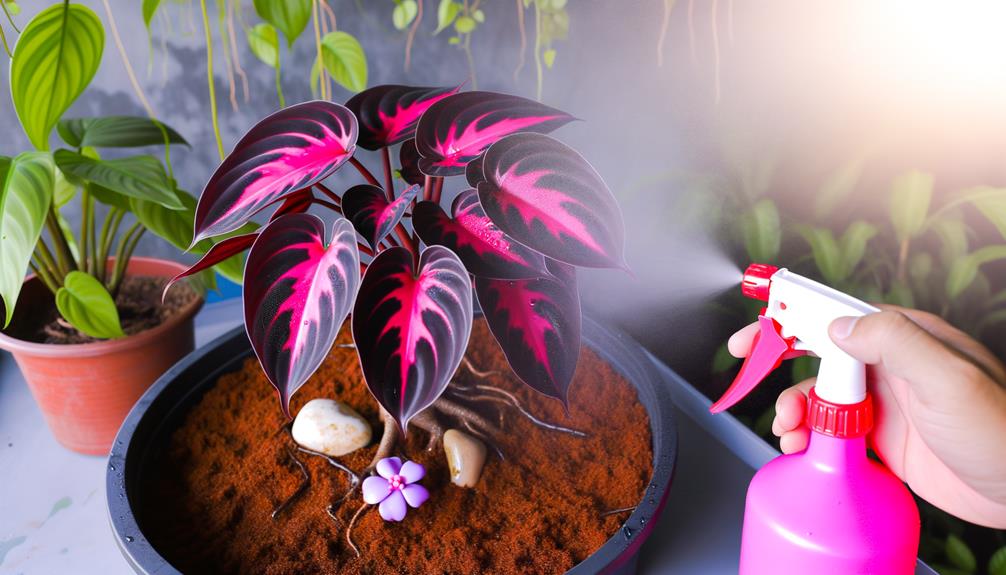
Proper care of the Black Cherry Pink Princess Philodendron involves maintaining a consistent environment with indirect light, well-draining soil, and balanced moisture levels to support best growth and vibrant variegation. Ideal lighting is achieved with bright, indirect sunlight, which prevents leaf scorching while promoting vivid coloration.
Utilize a potting mix composed of peat, perlite, and orchid bark to ensure sufficient drainage and root aeration. Watering should be moderate; allow the top 2-3 inches of soil to dry between waterings to avoid root rot. Maintain humidity levels between 60-80% and temperatures between 65-80°F for optimal growth.
Fertilize monthly during the growing season with a balanced, water-soluble fertilizer to support nutrient needs. Regular pruning encourages bushier growth and variegation.
Propagation Tips
Successfully spreading the Black Cherry Pink Princess Philodendron can be achieved through stem cuttings, which should include at least one node and a healthy leaf. Begin by using sterilized pruning shears to obtain a cutting approximately 4-6 inches in length.
The presence of aerial roots on the cutting can enhance successful rooting. Place the cutting in a container filled with a well-aerated medium, such as a mixture of perlite and peat moss, to promote root development. Maintain medium moisture without waterlogging, and ensure high humidity levels.
Position the container in indirect, bright light to facilitate photosynthesis and growth. Rooting hormone application may expedite root formation. Expect visible root establishment within 4-6 weeks under ideal conditions.
Common Issues and Solutions
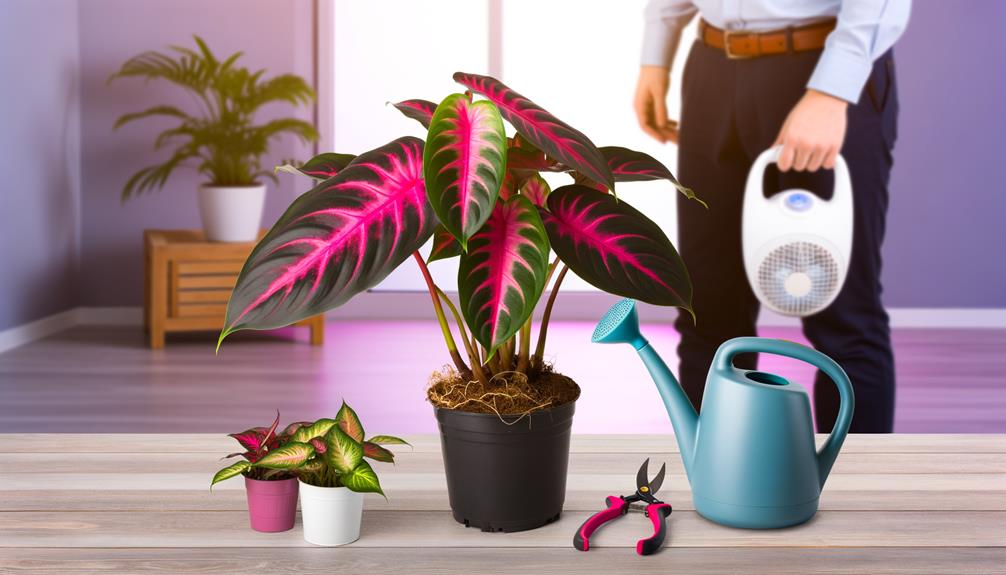
Common issues encountered when growing the Black Cherry Pink Princess Philodendron include leaf yellowing, root rot, and pest infestations, each of which requires specific interventions to ensure plant health.
Leaf yellowing often results from overwatering or insufficient light; adjust watering schedules and make sure the plant receives indirect sunlight.
Root rot, caused by waterlogged soil, necessitates improved drainage; repotting with a well-aerated mix can mitigate this issue.
Pest infestations, such as spider mites and aphids, can be controlled using insecticidal soap or neem oil. Regular inspection of foliage and stems is important for early detection and intervention.
Maintaining ideal environmental conditions—humidity levels between 60-80% and temperatures of 65-75°F—further enhances the plant's resilience against these common problems.
Conclusion
The Black Cherry Pink Princess Philodendron, with its striking variegation and unique pigmentation, serves as a tribute to the marvels of botanical diversity.
Just as a master painter blends shades to create a masterpiece, the plant's intricate coloration results from meticulous genetic variation and cultivation.
Enthusiasts who explore its care and propagation find rewarding success, mirroring the precision and dedication akin to an artist's craft.
The plant's allure lies in its harmonious blend of beauty and complexity.


